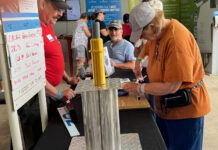
AirVenture 2021 has just concluded as I scratch this out, making it a good time for a warble about the doings seen and heard while wandering Wittman Field.
Definitely the first takeaway was there was an AirVenture in 2021. After a forced year off, attendance was excellent. It’s easy to take big events for granted, to think they’ll run forever on their own inertia, but they don’t. They require the constant input of energy supplied by enthusiastic attendees and exhibitors. After a year off, everyone seemed particularly happy to simply be there.
If the continued existence of the event was appreciated but not a major talking point, the demand for parts and services was. Nearly every vendor reported business is boiling, and if they could make more product, they’d be shipping it. One engine vendor said up to 40% more, which even if inflated gives a measure to the hugely increased demand.
Why can’t the manufacturers supply more product? Because COVID-19 plowed through the supply chain like a 747 bellying in across a railroad yard. Acme Aero can’t ship its product until that product is finished down to the last sticker and inch of safety wire, and if any part is missing, there is no sale. The aviation supply chain was a close-run thing before COVID, with perhaps one foundry in the world supplying Lycoming crankshafts to the entire industry, for example, and until all these shops return to full-time work, shortages will remain.
In fact, this duality of demand dampened by an inability to meet it was the theme of the show. The demand, of course, was a joy to hear and clearly reassuring to those in business, if only because it has been so rare in general aviation since the 1970s. For once all that dirge about the inexorable downward trend, aging pilots and so on was replaced by the needs of a bustling market restless to get moving. Heady stuff, almost to the point of disbelief.
To bird walk for a moment, why would our market grow? Surely the aging demographics and regulatory quagmire surrounding aircraft development are large suppressants. But the development of ever better engineered, easier-to-build kits has helped the Experimental segment. So has the transformation to digital navigation and instrumentation. In short, building—or should we say assembling—your own plane has never been easier, and you’d think that would help. It’s also easier to build a superior aircraft today. With more features and more robust navigation and communications gear, the modern homebuilt is a practical thing.
Staying in medical is also easier, building and maintenance support is easier to find, backcountry camping has opened a new use, and—not to sing in the past tense—fuel has been relatively affordable the last several years.
True growth in the homebuilt market is, of course, the best news ever. And the fundamental improvements in the kit-building world we’re now enjoying will certainly help when the market inevitably slows (let’s not say bursts). As the current overheated demand (40% growth is unsustainable in any market) is filled and today’s exuberant enthusiasm settles into the longer run of actually bucking rivets, the pace will slow.
Powering the Future
That sales were up was definitely the buzz of the moment at Oshkosh, but likely of larger importance was the STC for GAMI’s G100UL avgas. To the average showgoer this was another yawn of an industry announcement, but the ramifications in just a few years (or less) could be significant. These are still early days in the G100UL story, and there’s more research to do before reporting in depth on the new fuel; but for now let’s say the new avgas is a drop-in replacement for the familiar blue stuff and costs the 15% more that GAMI says it does. Let’s also go out on a limb and suppose regulatory forces see there is a viable alternative to leaded fuel and flat outlaw 100LL in the shorter term. The resulting increase in fuel prices can only be inflationary, not an aid to sustaining the happy days we’re now enjoying. GAMI is quick to point out there are cost offsets such as longer oil life, and we’re sure there are, but such a fundamental change is bound to cause turbulence. Just how much we can only wait to discover, along with the benefits of unleaded fuel, which are many.
Also at AirVenture were some first flights, or at least first public flights, of electric aircraft. There were also seminars, including an excellent overview of the state of electric flight by VerdeGo Aero. Not a bunch of university kids scaling up pizza delivery drones, VerdeGo is in the business of engineering and supplying both battery electric and hybrid systems to useful aircraft up to 7000 pounds.
There were a couple of takeaways here, the first being it takes a new airframe to realize the benefits of electric power, which is no surprise as it takes a new airframe even to fully realize the benefits of switching from air- to liquid-cooling. The other is electric power has its niches, and certainly promise, but the energy density of today’s batteries is an unsatisfactorily small percentage of diesel and gasoline fuels. VerdeGo put it as one pound of avgas has approximately 20 times the propulsion energy of one pound of lithium batteries once all the efficiencies are accounted for. Given the current rate of battery improvement, the widespread adoption of electric power thus remains something for our children to enjoy.
CFI Compensation
Curiously, the immediate flap over the definition of compensation for flight instructors and the resulting work-around via Letters of Deviation Authority was—outside of the FAA administrator’s remarks—not a topic in the circles I traveled in at AirVenture (I’m sure it was to those above my pay grade). While it seems the FAA really had its pliers stuck across both battery terminals on this one, it also seems the levers of power are in motion behind the scenes. Expect a resolution in government quick time, which is not to say overnight.
High Demand for Pilots
For me the best news is the increasing demand for airline pilots (and maintainers). There are many reasons for this, but core to me is the airlines are slowly realizing you can’t starve new hires for a decade and pay mediocre wages for a career requiring meaningful dedication, both in time, training and finances, plus beset by sudden termination due to health and age in any event. Demand for airplane pilots is hot, and this is drawing young people to aviation in numbers that would have been dismissed as wild dreaming a decade ago. One recruiter estimated career fairs at AirVenture—events catering to young adults—were up 50% in attendance. At least some of those people will want their own airplane along the way, and the roll-your-own Experimental option remains one of the best going—and getting better.
All said, there was an AirVenture 2021, and it was good.













